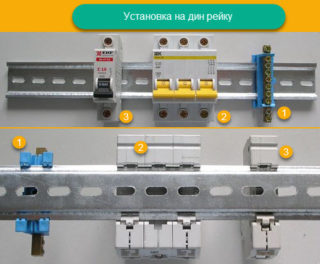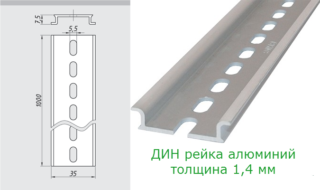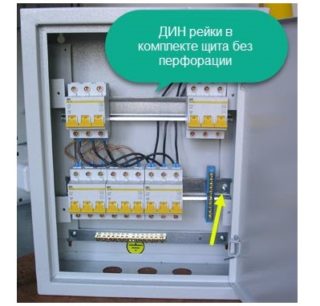A din rail is a special fixing strip that is placed in switch cabinets and similar prefabricated structures. Its main purpose is to serve as the basis for mounting RCDs, circuit breakers and other protective devices serving the power supply line. A din-rail of a standard size can accommodate several samples of devices of various classes at once, including powerful magnetic starters. It all depends on what is the specific width of the modular machine, determined by its functional purpose.
Types of din rails

Depending on the shape of the fastening strip, known samples of products of this class are divided into the following types:
- TN type rails (their varieties - TN 15, TN 35, TN 75);
- class "C" products (C20, 30, 40, 50);
- G-type strips (G 32).
The first of these designs resembles the letter of the Greek alphabet "omega" in shape and is the most common among the industrial designs. On it are traditionally mounted cases of electricity meters and machines.
For C-models, the side edges are bent inward, so that its profile allows you to fix terminal blocks of a special shape and design. The G-bar is a slightly modified modification that is rarely used and used for the same purposes. The length of these fasteners, depending on the manufacturer, varies from 7.5 cm to 2 meters, which allows placing from 4 to 96 pieces of protective devices on them with the standard width of one machine module.
According to their design, din-rails are perforated - with holes filled along the entire length - and solid or cast.
The advantage of the first structures is the ease of installation, since in the presence of holes filled with a pitch of 10-15 mm, it is much easier to fasten the steel rail. But cast samples are more durable and reliable. They do not deform when there are a large number of machines in the switchboard.
Application features
In accordance with this definition, the scope of its application extends to the following cases:
- the need to install electric meters and other samples of measuring equipment in the switch cabinet;
- the need to place protective equipment in the same place (RCDs, difavtomats, voltage relays, and the like);
- if desired, install special connecting fittings into the cabinet.
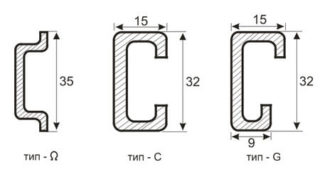
The decisive factor that determines the capacity of such a rail is the width of the machine module or similar protective equipment installed on its base.
When evaluating the width of the machines, they proceed from the specific number of protective devices used in the dashboard, which can have a single-pole or multi-pole design. The second option concerns three-phase networks. In the general case, its application is limited to this particular set of functions, but in some situations, other directions of using the din rail are also possible.
Dimensions and installation method
The installation product is fixed at two extreme points of the strip so that no parts are formed that protrude beyond the cut of the guides. That is, the lengths of the workpieces are selected exactly in size, for which the lateral surpluses are cut off in advance.
In hard-to-reach places with difficult working conditions with modular equipment, it is allowed to install holders for din rails of a special design. Such guides, if desired, allow you to rotate them at a convenient angle.
Calculation of module width
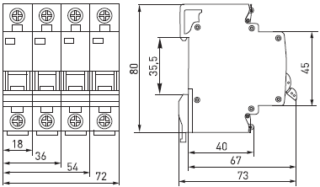
The dimensions or dimensions of DIN rail mounted circuit breakers are usually calculated taking into account the following considerations:
- how many of these devices are planned to be installed in accordance with the used wiring diagram;
- what type of metering device (meter) and circuit breakers are supposed to be mounted on it;
- what is the minimum gap between these devices should be left.
If two automatic machines or RCDs are allowed to be mounted almost close to each other, the devices have to be installed next to the electric meter at a certain distance (at least 1-2 centimeters).
When calculating the number of devices that fit on a DIN rail, their functional purpose must be taken into account. A two-pole circuit breaker is wider than a single-pole one.
Materials for manufacture and load characteristics
The material from which a particular din-rail is made must correspond to its purpose. This means that it is necessary to take into account the expected loads, depending on which steel or aluminum products are selected. The first of these samples are structurally more durable and withstand extreme loads with a minimum strip thickness of only 1 mm.
Critical or ultimate loads are understood as the situation when dimensional devices such as frequency converters, powerful magnetic starters or power three-phase automatic devices are mounted on the rail.
Aluminum slats are capable of "holding" the maximum stresses of mechanical deformations only with a thickness of 1.5 mm. Accordingly, the set of power and protective equipment placed on them will be significantly limited.
Load characteristics
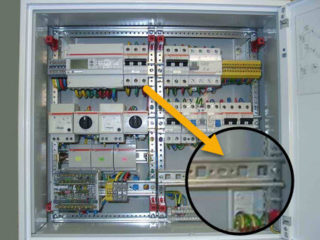
Since a typical DIN rail is manufactured as a shaped product, it can withstand higher deformation loads than a metal plate of the same size. Typical load characteristics of DIN rails are standardized by the current standards for a number of features, including the type of metal. Aluminum strips are available in the following versions:
- rails with a thickness of 1 mm, designed for the installation of single modular devices: circuit breakers, RCD blocks, power modules;
- strips 1.1 mm, designed for the installation of single devices placed in several rows;
- the same products, but with an indicator of 1.4 mm, designed for modular equipment of any class and weight.
All these products are cut into pieces of the required length before installation.
The set can include steel rails with a thickness of 1.0 mm, similar in load capacity to an aluminum rail with a thickness of 1.5 mm. They can withstand maximum loads without restrictions on weight and number of seats within the permissible size. In addition, manufacturers of switchboard equipment often equip switchgear cabinets with non-standard profile rails.
How to choose rails for installation in a cabinet
Immediately before use, they are cut into workpieces of the required size for the dimensions of the housing of ready-made switchboards. In this case, each specific rail is adjusted in length to the required standard size. When assembling a new flap, its dimensions are selected based on the finished rails plus a small margin.
The size of the DIN-rail machine is of decisive importance in the design of switchgear of various classes. Only taking this indicator into account can it be correctly calculated its operational parameters and the permissible load on the supporting elements of the structure.

